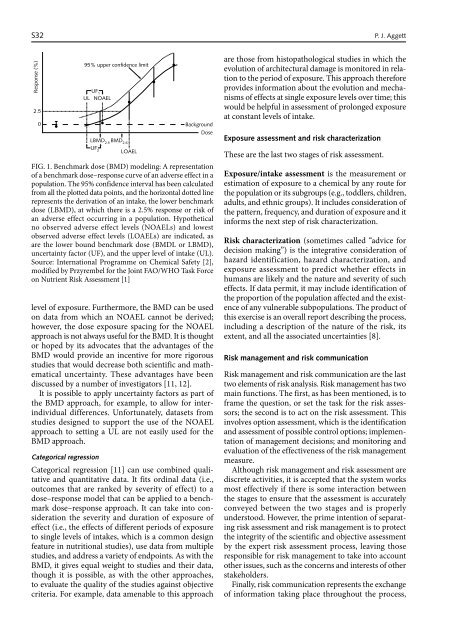Implementing food-based dietary guidelines for - United Nations ...
Implementing food-based dietary guidelines for - United Nations ...
Implementing food-based dietary guidelines for - United Nations ...
Create successful ePaper yourself
Turn your PDF publications into a flip-book with our unique Google optimized e-Paper software.
S32<br />
�������� ���<br />
���<br />
�<br />
level of exposure. Furthermore, the BMD can be used<br />
on data from which an NOAEL cannot be derived;<br />
however, the dose exposure spacing <strong>for</strong> the NOAEL<br />
approach is not always useful <strong>for</strong> the BMD. It is thought<br />
or hoped by its advocates that the advantages of the<br />
BMD would provide an incentive <strong>for</strong> more rigorous<br />
studies that would decrease both scientific and mathematical<br />
uncertainty. These advantages have been<br />
discussed by a number of investigators [11, 12].<br />
It is possible to apply uncertainty factors as part of<br />
the BMD approach, <strong>for</strong> example, to allow <strong>for</strong> interindividual<br />
differences. Un<strong>for</strong>tunately, datasets from<br />
studies designed to support the use of the NOAEL<br />
approach to setting a UL are not easily used <strong>for</strong> the<br />
BMD approach.<br />
Categorical regression<br />
��� ����� ���������� �����<br />
��� �� �����<br />
��� ���<br />
���� ���<br />
�� �<br />
�����<br />
����������<br />
����<br />
FIG. 1. Benchmark dose (BMD) modeling: A representation<br />
of a benchmark dose–response curve of an adverse effect in a<br />
population. The 95% confidence interval has been calculated<br />
from all the plotted data points, and the horizontal dotted line<br />
represents the derivation of an intake, the lower benchmark<br />
dose (LBMD), at which there is a 2.5% response or risk of<br />
an adverse effect occurring in a population. Hypothetical<br />
no observed adverse effect levels (NOAELs) and lowest<br />
observed adverse effect levels (LOAELs) are indicated, as<br />
are the lower bound benchmark dose (BMDL or LBMD),<br />
uncertainty factor (UF), and the upper level of intake (UL).<br />
Source: International Programme on Chemical Safety [2],<br />
modified by Przyrembel <strong>for</strong> the Joint FAO/WHO Task Force<br />
on Nutrient Risk Assessment [1]<br />
Categorical regression [11] can use combined qualitative<br />
and quantitative data. It fits ordinal data (i.e.,<br />
outcomes that are ranked by severity of effect) to a<br />
dose–response model that can be applied to a benchmark<br />
dose–response approach. It can take into consideration<br />
the severity and duration of exposure of<br />
effect (i.e., the effects of different periods of exposure<br />
to single levels of intakes, which is a common design<br />
feature in nutritional studies), use data from multiple<br />
studies, and address a variety of endpoints. As with the<br />
BMD, it gives equal weight to studies and their data,<br />
though it is possible, as with the other approaches,<br />
to evaluate the quality of the studies against objective<br />
criteria. For example, data amenable to this approach<br />
are those from histopathological studies in which the<br />
evolution of architectural damage is monitored in relation<br />
to the period of exposure. This approach there<strong>for</strong>e<br />
provides in<strong>for</strong>mation about the evolution and mechanisms<br />
of effects at single exposure levels over time; this<br />
would be helpful in assessment of prolonged exposure<br />
at constant levels of intake.<br />
Exposure assessment and risk characterization<br />
These are the last two stages of risk assessment.<br />
Exposure/intake assessment is the measurement or<br />
estimation of exposure to a chemical by any route <strong>for</strong><br />
the population or its subgroups (e.g., toddlers, children,<br />
adults, and ethnic groups). It includes consideration of<br />
the pattern, frequency, and duration of exposure and it<br />
in<strong>for</strong>ms the next step of risk characterization.<br />
Risk characterization (sometimes called “advice <strong>for</strong><br />
decision making”) is the integrative consideration of<br />
hazard identification, hazard characterization, and<br />
exposure assessment to predict whether effects in<br />
humans are likely and the nature and severity of such<br />
effects. If data permit, it may include identification of<br />
the proportion of the population affected and the existence<br />
of any vulnerable subpopulations. The product of<br />
this exercise is an overall report describing the process,<br />
including a description of the nature of the risk, its<br />
extent, and all the associated uncertainties [8].<br />
Risk management and risk communication<br />
P. J. Aggett<br />
Risk management and risk communication are the last<br />
two elements of risk analysis. Risk management has two<br />
main functions. The first, as has been mentioned, is to<br />
frame the question, or set the task <strong>for</strong> the risk assessors;<br />
the second is to act on the risk assessment. This<br />
involves option assessment, which is the identification<br />
and assessment of possible control options; implementation<br />
of management decisions; and monitoring and<br />
evaluation of the effectiveness of the risk management<br />
measure.<br />
Although risk management and risk assessment are<br />
discrete activities, it is accepted that the system works<br />
most effectively if there is some interaction between<br />
the stages to ensure that the assessment is accurately<br />
conveyed between the two stages and is properly<br />
understood. However, the prime intention of separating<br />
risk assessment and risk management is to protect<br />
the integrity of the scientific and objective assessment<br />
by the expert risk assessment process, leaving those<br />
responsible <strong>for</strong> risk management to take into account<br />
other issues, such as the concerns and interests of other<br />
stakeholders.<br />
Finally, risk communication represents the exchange<br />
of in<strong>for</strong>mation taking place throughout the process,




